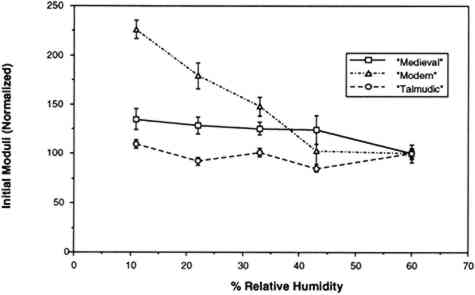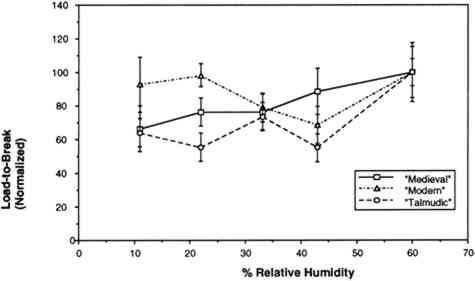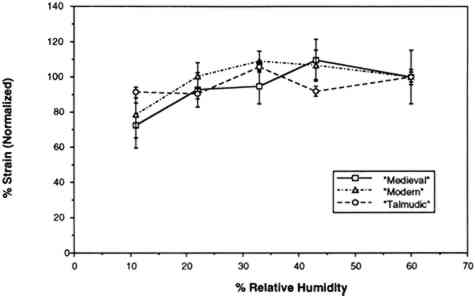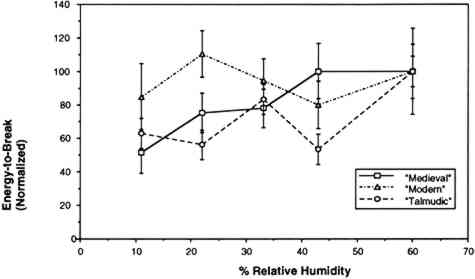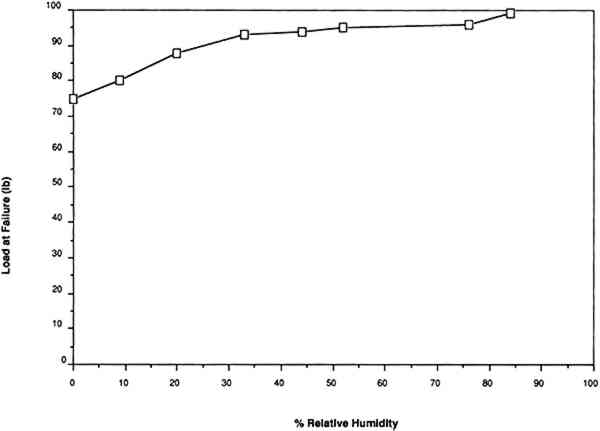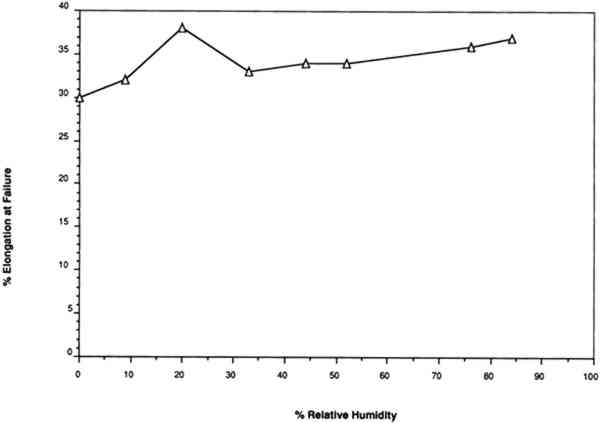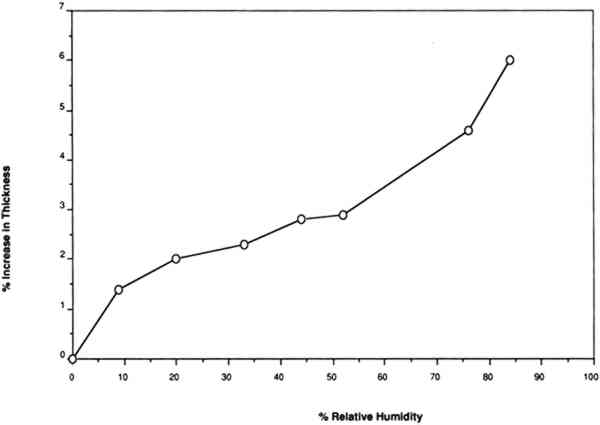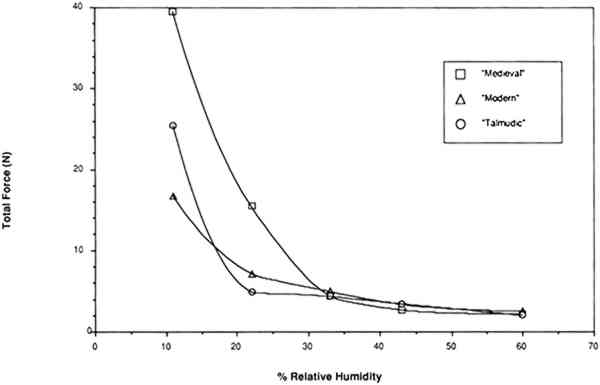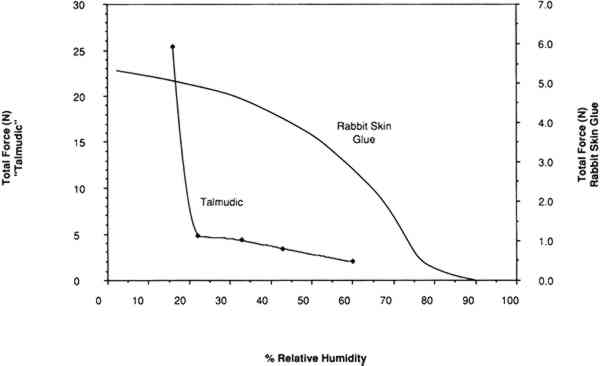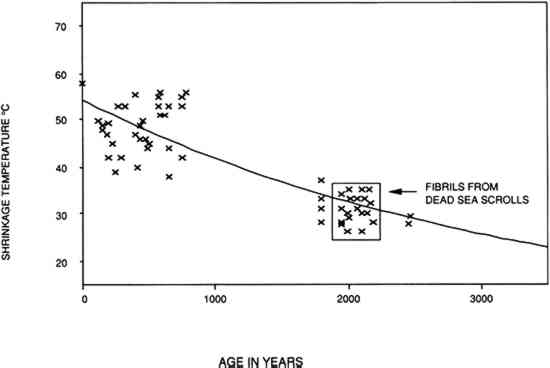THE EFFECTS OF RELATIVE HUMIDITY ON SOME PHYSICAL PROPERTIES OF MODERN VELLUM:ERIC F. HANSEN, STEVE N. LEE, & HARRY SOBEL
4 RESULTS AND DISCUSSION4.1 RESULTS OF TENSILE TESTINGThe properties of the vellum used in this testing should reflect those of vellum that has not been treated with softening agents or other additives. The initial modulus, load-to-break, percent strain-to-break, and energy-to-break (tensile energy absorption) obtained from tensile fracture after equilibration at different relative humidities are tabulated in tables 2, 3, 4, and 5, respectively. The same properties, with standard error values used for error bars and normalized to a value of 100 for a tensile property of each type of vellum at 60% RH, are shown in figures 6, 7, 8, and 9. The tensile properties were normalized to more clearly illustrate a comparison of the relative change for each type of vellum. (As the response of the humidity sensor is not linear below 20% RH, the recorded value was 15% over a saturated lithium chloride solution. Since the recognized RH of a saturated lithium chloride solution is 11%, this value is used in the charts and graphs.) TABLE 2 INITIAL MODULUS OF THREE VELLUM TYPES AT DIFFERENT RELATIVE HUMIDITIES TABLE 3 LOAD-TO-BREAK OF THREE VELLUM TYPES AT DIFFERENT RELATIVE HUMIDITIES TABLE 4 % STRAIN-TO-BREAK OF THREE VELLUM TYPES AT DIFFERENT RELATIVE HUMIDITIES TABLE 5 ENERGY-TO-BREAK OF THREE VELLUM TYPES AT DIFFERENT RELATIVE HUMIDITIES
The initial modulus determined for the modern-type vellum is increased to the greatest extent as a result of equilibration at lower relative humidities, with the medieval-type vellum showing a similar trend. The value of the initial modulus for the talmudic-type parchment is relatively unaffected. The effect of changes in relative humidity on the load-to-break mean obtained after equilibration and fracture is greatest for the medievaltype vellum, with a reduction in the load-to-break mean for each reduction in RH over the range from 60% to 11%, and with the value at the lowest RH significantly different from the value at the highest RH. In contrast, the talmudic-type vellum has relatively static values in the region from 43% to 11% RH, with a reduction in the loads-to-break mean only upon There is no significant change in the percent strain-to-break at different relative humidities for talmudic-type parchment. However, while the values for both the modern and medieval types remain static from 60% to 22% RH, there is a clear reduction in percent strain-to-break upon reducing the RH below 22% to 11%. The energy-to-break is calculated from the area under the stress-strain curves. Because the energy required to fracture a sample reflects changes in both the ability to elongate and also to bear a load, this quantity is most representative of the tendency of parchment to fracture at a certain level of relative humidity. However, this quantity also has a wider spread in the standard error because both the uncertainty in the strain-to-break and load-to-break are represented. For the vellum type designated modern, decreasing the relative humidity from 60% to 11% does not result in a mean value outside the uncertainty (standard error) of the values at 60%. For the medieval-type parchment, there is a clear reduction in the mean energy-to-break to half (50%) the original value; the energy-to-break of the talmudic-type parchment is also reduced at lower relative humidities, but to a lesser extent than in the medieval-type.” Does the effect of lowering the relative humidity increase the “brittleness” of newly manufactured vellum? To answer this question, the difference between “brittleness” and “stiffness” should be defined. A “stiffer” material has a higher value for the initial modulus (an indication of inelastic deformation), and therefore the vellum prepared by the modern method became stiffer with a decrease in humidity. “Brittleness,” however, is a reduction in the ability to elongate before breaking. Therefore both the medieval-type and modern-type vellum can be considered more brittle at lower relative humidity levels. These results pertain to two questions:
For example, Werner (1968, 286) states that “parchment documents … kept under conditions that are too dry, say at 45 percent relative humidity or lower … tend to cockle and to become rather rigid.”Wilson (1986), in reviewing storage conditions for leather in archives and libraries, considered the results of testing the tensile properties and dimensional changes of vegetable-tanned leather by Evans and Critchfield (1933), reproduced in figures 10 through 12. He concluded that the changes were not large enough to preclude the storage of vegetable-tanned leather at any of these relative humidities on the basis of these data alone. The same general conclusions can be reached for the results of tensile testing on vellum presented here, except for the fact that at 11% RH a notable reduction is evident in some individual properties of specific vellum types: the load-to-break of the medieval-type vellum; the strain-to-break of the medieval-type and modern-type designated vellum; and the energy-to-break of the vellum designated talmudic.
Several effects may account for observations other than those presented here that some parchment becomes brittle below 43% RH. As originally produced, skin artifacts should vary in tensile properties for a variety of reasons including the age at which the animal was slaughtered, the species of the animal, the health of the 4.2 RESULTS OF TESTING RESTRAINED SAMPLESThe same relative behavior was observed for all three types of vellum when restrained at a fixed gauge length and the relative humidity was lowered. As the humidity was lowered from 60% to 22%, relatively little force developed in a restrained sample. However, as the water content was decreased below that contained in vellum equilibrated at 22% RH, there was a significantly large increase in the force (fig. 13). These results clearly indicate that around 25% is the lowest level that can be tolerated without inducing large forces in the vellum.
The last result may be explained in reference to the four regions of water sorption associated with the collagen molecule. Below 25% RH, water is removed from the tropocollagen structure, causing an unstable chemical state and, as indicated by the forces developing upon shrinkage, an undesirable mechanical state. A comparison of the force developing as the relative humidity is lowered in a restrained sample of vellum (with a high portion of intact collagen) with the force developing in a sample of cast rabbit skin glue (a highly gelatinized material) is shown in figure 14. A completely different profile, noticeably lacking a large increase in stress below 22%, results in the plot of force development versus relative humidity in the case of rabbit skin glue, wherein little intact tropocollagen is present.
4.3 IMPLICATIONS FOR STORAGE CONDITIONSAs has been shown, a minimum level of relative humidity should be maintained; storage of a parchment below 25% RH is not indicated. Above this relative humidity all strongly water sorbing groups in collagen should be saturated. A similar position was taken by the National Bureau of Standards when the display and storage conditions for the Charters of Freedom of the United States (Declaration of Independence and the Constitution) were defined in 1951 (NBS 1951). These parchment documents are stored under an inert atmosphere of helium humidified to 25% relative humidity. The reasoning of the NBS was based on two sources:
The Charters of Freedom were examined by a panel of scientists and conservators in 1982 without removal from the case (Calmes 1985). No evidence of deterioration beyond that observed Several issues can be raised about the advisability of the long-term storage or display of parchment below the current recommendations for relative humidity, which are usually 50%.
However, there are also several issues that should be raised about the advisability of a 50% RH level for the display and storage of ancient and culturally important parchment documents. The Dead Sea Scrolls are an example of parchment documents whose condition (present state of deterioration) demands further consideration. The Dead Sea Scrolls are a collection of more than 500 parchment documents, many of which are incomplete. The first documents were found in Jordan in 1947. Their manufacture has been attributed to the Quran community (a Jewish sect) and roughly dated between 200 B.C. and 100 A.D. The technology used in their manufacture differs from other parchment manuscripts in that lime was probably not used in the dehairing bath and in the presence of surface tannage (Poole and Reed 1962). In attempting to date the Scrolls, Burton et al. (1959) compared the shrinkage temperature of collagen fibers in the scroll fragments to the shrinkage temperature of samples from parchment or raw hide of known origin (between 1000 B.C. and 1000 A.D.). They reasoned that any degenerative changes in the collagen fibers would be due to the passage of time. The results, shown in figure 15, show that the shrinkage temperature of collagen from the Scrolls, like other older collagen, is low (between 22�C and 35�C) and consistent with the probable time of origin.
Other studies have shown that much of the collagen is not intact. Weiner et al. (1980) examined small pieces of scroll material and random, unwritten fragments to determine the collagen to gelatin ratio using x-ray diffraction and amino acid racemization analyses. By their x-ray diffraction method, they determined the collagen to gelatin indices (C:G) of modern rattail collagen to be 10:2, and the C:G of gelatinized rattail collagen to gelatin to be 0:7. C:G indices of modern parchment samples were 9:9, 9:8, and 12:5. The C:G indices of 34 samples from scrolls or fragments ranged from Samples of scroll fragments were recently analyzed at the Getty Conservation Institute (Derrick 1992) by Fourier transform infrared spectroscopy (FTIR) using both a surface technique (attenuated total reflection) and an FTIR microscope to scan cross sections. This method can detect increased denaturation by a shifting of an absorption band to a lower frequency. The amide II band shifts from 1550 to 1530 cm-1 when the collagen helix is converted to gelatin (Brodksy-Doyle et al. 1975; Susi et al. 1971). Differences in chemical composition resulting from hydrolysis or oxidation can be detected by spectral comparison of modern parchment samples and samples from the scrolls. Analysis indicated evidence of denaturation, hydrolysis, and oxidation that were associated to a greater extent with both brittle areas and also darker, discolored areas. Further analysis included amino acid analysis of modern parchment and scroll parchment by High Performance Liquid Chromatography. Modern parchment was 90% or more extractable by weight, when extracted for collagen, in the preparatory acid hydrolysis prior to amino acid analysis. In contrast, scrolls fragments were less than 70% extractable by weight, indicating extensive oxidative modification of amino acids may have occurred. The Dead Sea Scrolls, then, exhibit a state of deterioration consistent with their age. The extent of degradation is varied but includes evidence of hydrolysis and oxidation in addition to denaturation. Problems that exist with a 50% recommended relative humidity for parchment documents are:
The Dead Sea Scrolls are of particular interest and cultural importance, being among the earliest The above considerations indicate that the practice of humidifying brittle historical parchment at 100% RH to relax the material may be questionable. Exposure to a high relative humidity may have the transitory, beneficial effect of relaxing the parchment to allow unrolling or other manipulations. However, the chemical state of the material, both immediately after relaxation and in the future, needs to be more fully determined regarding possible adverse affects. |
